Losing a beloved pet to any cause is devastating, but when that loss is due to an accident that could have been prevented, the pain is compounded by feelings of guilt and regret. Electrocution, while rare compared to other causes of death in dogs, can be particularly tragic because it often occurs suddenly and without warning. It’s crucial for dog owners to understand the risks associated with electrical hazards and take proactive steps to protect their furry companions from this silent killer.
Understanding Electrical Hazards:
Dogs are naturally curious creatures, and they don’t always recognize dangers that humans would instinctively avoid. This makes them susceptible to accidents involving exposed wires, cords, or even seemingly innocuous objects like toys or chews that may conduct electricity if damaged or wet. According to recent statistics, approximately 1% of all reported cases of accidental deaths among pets involve electrocution, which translates to hundreds of preventable fatalities each year.
Signs of Electrical Injury in Dogs:
If your dog has come into contact with an electric current, you might notice one or more of these signs:
– Vocalization (whining, yelping)
– Painful muscle spasms
– Uncontrolled paddling movements
– Burns around the mouth or paw pads
– Weakness, paralysis, or collapse
– Heart rhythm abnormalities
In severe cases, immediate veterinary attention is critical as the shock can lead to cardiac arrest or respiratory failure within minutes.
Prevention Measures:
To keep your dog safe from electrical hazards, follow these guidelines:
- Educate Yourself: Learn about potential sources of electrical danger in your home and how to identify them.
- Inspect Your Home Regularly: Check for frayed wiring, loose plugs, or worn insulation on extension cords. Replace any items that pose a risk immediately.
- Keep Cords Out of Reach: Store cords out of sight or use cord covers to make them inaccessible to curious paws.
- Use Ground Fault Circuit Interrupters (GFCIs): Install GFCIs in areas where water and electricity mix, such as kitchens, bathrooms, and outdoor outlets. These devices can sense small imbalances in the flow of electricity and shut off power before it becomes dangerous.
- Supervise Playtime: Keep a close eye on your dog during play sessions, especially if he loves chewing on things – some chew toys can break apart exposing metal parts that carry current.
- Train Safe Behavior: Teach your dog not to touch electrical outlets or cords. Positive reinforcement techniques work best; reward calm behavior around potentially hazardous areas.
- Regular Maintenance: Schedule regular inspections with a qualified electrician to ensure your home’s electrical system is up to code and free from defects.
Conclusion:
By being aware of the risks and taking preventive measures outlined above, you can significantly reduce the chances of a fatal incident occurring. Remember that prevention is key—a little extra effort goes a long way toward keeping our four-legged friends safe from harm. Always err on the side of caution when dealing with electricity and never leave your dog unattended near any source of power unless you are absolutely sure it poses no threat. Your vigilance will help create a safer environment for both you and your loyal companion.
